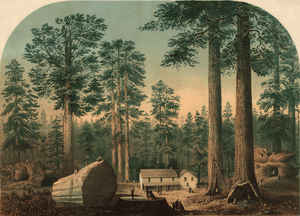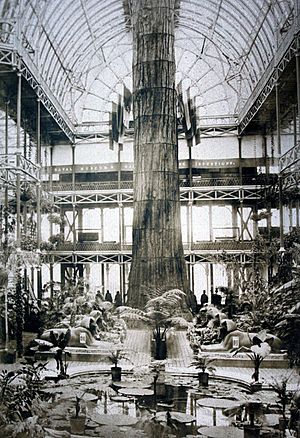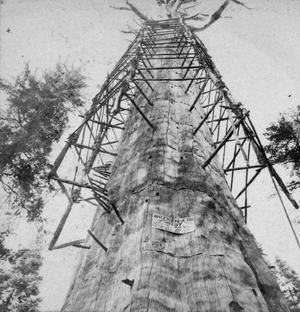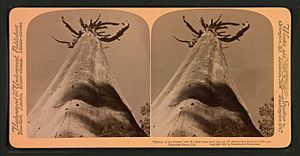Mother of the Forest facts for kids
The Mother of the Forest was a giant and very old tree. It was a type of tree called a Sequoiadendron giganteum, also known as a giant sequoia. This amazing tree lived in the Sierra Nevada Mountains in central California, USA. Today, what is left of the tree can be found in the Calaveras Big Trees State Park, in Calaveras County, California. The Mother of the Forest lived for a very long time, from about 667 BCE until around 1856 CE.
Contents
The Mother of the Forest: A Giant Discovery
In 1852, a man named Augustus T. Dowd found and recorded 92 giant sequoia trees in a valley. The Mother of the Forest was the second largest tree he found. The biggest one was later named "The Big Stump." People said the Mother of the Forest stood about 328 feet (100 m) tall. Its base was also very wide, measuring about 93 feet (28 m) around.
Removing the Bark for Exhibitions
During the California Gold Rush, many people were looking for new riches. At that time, photography was not good enough to show how huge these trees were. So, people sometimes cut down trees and moved them to big cities. This was done to prove that such giant trees really existed.
In 1854, three men named William Lapham, George L. Trask, and George Gale decided to remove the bark from the Mother of the Forest. They wanted to put it back together for shows. Workers drilled holes into the tree using special tools called pump-augers. They put rods into these holes to hold up scaffolding and the workers. Then, they sawed off the bark.
It took over 90 days to remove 60 tons of bark. The bark pieces were about 8 feet (2.4 m) high and 2 to 5 feet (0.61 to 1.52 m) wide. They removed bark up to 116 feet (35 m) high on the tree. At the bottom, the bark was 18 inches (46 cm) thick. On average, it was 11 inches (28 cm) thick. George Gale sent pieces of the tree to experts. They found out the tree was 2,520 years old!
Traveling the World: The Bark on Display
The removed bark pieces were sent by ship all the way around Cape Horn to New York City. In 1855, the bark was put back together in the shape of the tree. It was shown at an exhibition called "vegetable wonders of the gold regions" at the New York Crystal Palace.
After New York, the bark traveled to London in 1856. It was shown in Hyde Park. People were so interested that the bark pieces were moved to The Crystal Palace in London's Sydenham the next year. It was presented as the trunk of a 3,000-year-old tree. The exhibition made a lot of money. The bark stayed there until 1866, when a big fire destroyed the palace and the bark.
The Tree's Fate in California
The Mother of the Forest tree in Calaveras Grove did not live much longer after its bark was taken off. In 1856, the tree still had all its leaves. But within five years, it had no leaves left. People had a plan to build a spiral staircase around the bare tree. This would let visitors go high up and see the view. An old book from 1886 mentions that visitors carved their names and dates into the tree at different heights.
In 1908, a fire swept through the area. Since the tree no longer had its fire-resistant bark, much of what was left of it burned away.
Protecting Giant Sequoias: A Lasting Legacy
The exhibitions of the giant trees in the 1850s caused a lot of public anger. People were upset that these huge trees were being destroyed. In 1864, Senator John Conness helped create the Yosemite Grant. He said that even after seeing the Discovery Tree and the Mother of the Forest, people still didn't believe these trees were real. He argued that the areas where they grew should be protected.
In 1903, President Theodore Roosevelt visited the Yosemite sequoias with John Muir. Roosevelt then gave a speech saying, "As regards some of the trees, I want them preserved because they are the only things of their kind in the world."
Conservation Efforts
Around the early 1900s, several lumber companies owned the tree and its surroundings. They planned to cut down the remaining trees. Giant sequoias were seen as a great source of wood back then. This again caused a lot of public protest from local people and conservationists. They wanted the area to remain a tourist attraction.
Over time, more and more sequoia areas, including Yosemite, became protected. In 1931, Calaveras Grove became part of California State Parks.
The Mother of the Forest Today
Today, if you visit the North Grove loop trail, you can still see what is left of the Mother of the Forest. It stands as a tall, fire-blackened snag. You can still see the saw marks on the trunk from when its bark was cut away. The remaining trunk is still over 100 feet tall.






